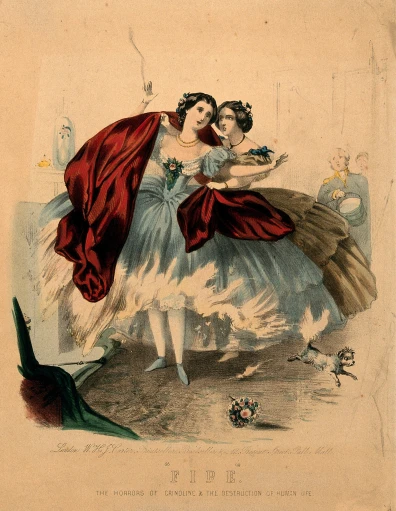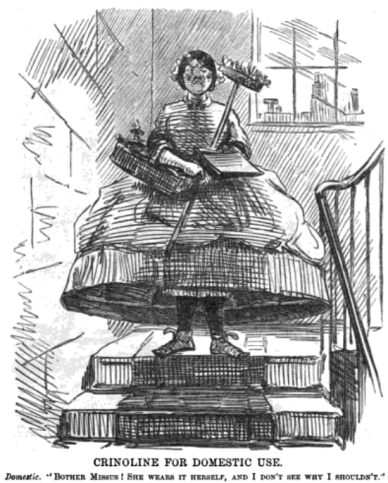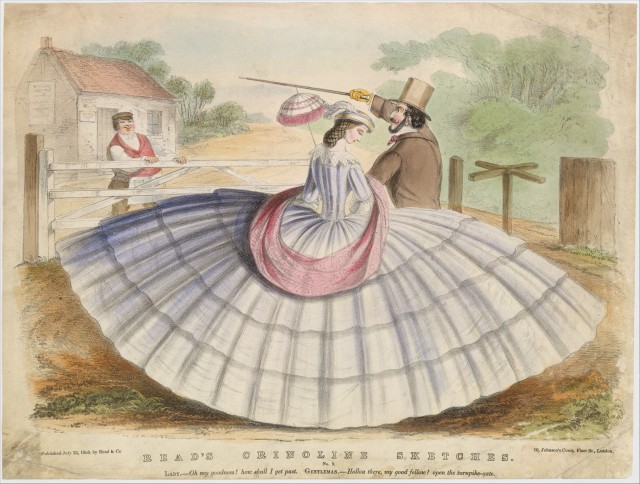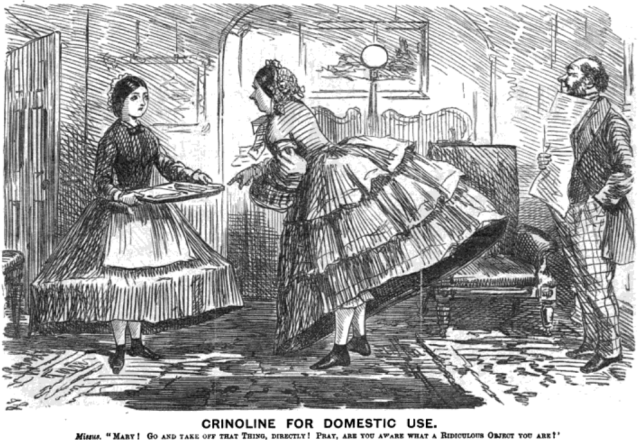
Browsing through the 1869 Cassell’s Household Guide to Every Department of Practical Life, I came upon an intriguing recipe “To Render Ladies’ Dresses Incombustible.” If you mixed your whitening with starch, you could make “lace, net, muslin, gauze, or any other light stuff, perfectly inflammable. As white dresses are much worn at evening parties, where fires are often kept in the grates, and numerous ladies have been burnt to death by means of their dresses catching light whilst dancing, it is hoped this useful receipt will not be forgotten by any lady in the habit of attending balls and parties.”
Voluminous dresses were fashionable through the 1850s and 1860s, and a search through newspapers of that period turns up a shocking number of deaths from the garments catching fire. It’s thought that something like 3,000 women perished this way in England alone. Both Cassell’s advice and the lithograph above — labeled “the horrors of crinoline & the destruction of human life” — make us think of well-to-do ladies twirling in beautiful ballrooms before tragedy strikes; but all classes were caught up in the fashion craze Punch called “crinolinemania,” and the sparks of flame didn’t care if you were a colonel’s wife, like Anna Maria Grant, or a servant girl, like Mary Anne Winterbotham.
Anna Maria Grant was sitting in a London drawing room on Christmas Day in 1862. It was 11 o’clock in the morning, and a fire kept the winter chill away as she celebrated the holiday with friends. There was a bird loose in the room, and as she turned to follow its flap and flutter, the edge of her dress caught fire. At first she tried to tear off the clothes, but the flames spread quickly, and she was unable to escape them. Within two or three minutes, her clothing had entirely burned away, with the exception of her stays, and she had suffered “fearful injuries.” Two doctors were called in, and tended to her until 7 that evening, when she finally died from her wounds. The coroner lamented that crinolines had become a constant theme at inquests.

In November 1861, 22-year-old Mary Anne Winterbotham was a domestic servant working in a doctor’s home in London’s West End. She was cooking dinner when her dress caught fire and she ran out into the street, all alight and screaming for help. A crowd quickly gathered, and tried to tear at her fiery dress, and smother the flames with coats and rugs. Eventually the fire was put out, but Mary Anne, like Anna Maria, had suffered horrific injuries that her body could not withstand. At the coroner’s inquest, the jury found she had died from accidental burns, and added they could not part without expressing their “horror and disgust” at persons who wore crinolines when their duties required them to work with fire.
One wonders — was it easier to express “horror and disgust” for Mary Anne than for Anna Maria, whose ladylike duties required her to sit by a fire on Christmas morning?

Crinolines were constantly in the press in these years. Their wearers were teased and ridiculed for the indecent way such dresses exposed them when they bent forward; they were cautioned about the dangers of moving around in such cumbersome clothing. Just a couple of weeks before Mary Anne Winterbotham’s death, Florence Nightingale wrote that she found it “alarmingly peculiar” that at a time when “female ink-bottles” were so regularly espousing women’s overall usefulness to the world, women were dressing themselves in a way that rendered them useless for any duties at all. She called the crinoline “an absurd and hideous costume,” and wished the registrar-general would state the number of fatalities it had caused.
But still, the trend persisted. In 1869, a piece titled “Who Killed Crinoline?” said good riddance to the fad, and marvelled that it had lasted so long. “Some say crinoline was swept away by a grand tidal wave of common-sense. If so, the wave took about ten years to gather its volume; and we should be glad to know what arguments or recommendations common-sense possessed in the tenth year which it had not in the first.”

We confess to regarding crinoline as at once ugliness and a nuisance; but that the ladies will regard as only the general opinion of us “male creatures,” and they have proved that they do not care about that. The attachment to crinoline must be very strong, for it has stood what it most difficult to withstand—ridicule. Good things are often put down by sarcasm; but here is an ugly thing—a monstrosity—a something which makes the lower half of a lady’s figure look like a damaged diving bell; and the only effect ridicule had upon it, is to cause it to expand to larger and larger proportions, till it threatens to sweep the lords of creation off the pathways, to block them out of church, to hustle them out of places of amusement, and scarcely to leave room for them at home. We should not care so much if a sumptuary law could be passed, prohibiting any but ladies, who are ladies enough not to have anything to do, from wearing crinoline; but everybody takes to the nuisance. Folly is generally spoken of as “light,” but we are inclined to think it must be heavy, for it descends from the highest to the lowest grade of society. This folly commenced with a French Empress, and the other day a beggar woman in crinoline asked alms of us. The vortex a servant maid in the small room of a modest house creates with her wide mailed petticoat is perfectly bewildering, and half alarming. A servant maid has not time to move with the quiet, balloon-like glide, which a lady has leisure for. She must be sharp and quick in her movements; and she drags the chairs, and jostles the table, and puts the dishes in danger, and flounces papers away, as though she was a whirlwind; and when she puts coals on the fire, occasionally carries away the tongs as an appendage to her skirt, the fender only escaping reason of its weight. It says a great deal for the cautiousness of servant girls, that more of them have not fallen victims to crinoline fires. The sufferers in that way have been generally ladies. In factories, the factory lasses, though barefooted, are becrinolined, better fenced than the machinery they work among; and it is a wonder there is not more peril in their skirts than there appears to be. But putting aside ugliness and danger, we have now to contemplate crinolines as plunder baskets. … many crinolines are simply depots for stolen goods. It does not, of course, follow that all people who wear crinolines use them for that purpose; but gives those of predatory dispositions an opportunity of concealing their booty. Lumps of plunder, which would deform the symmetry of the uncrinolined female figure, are carried off without suspicion by the crinolined, pots of jelly and marmalade, pounds of apples and sugar, papers of “sweeties,” are “conveyed” into the capacious receptacle; and we are told that silk, and the finer sorts of yarns, find their way surreptitiously to the same place. Jute, we suppose, has too little value to be in danger. We propose, then, to call crinolines Plunder Baskets. If everybody would do that, we wonder if the ladies would continue to wear them under that name?
“Plunder Baskets.” Dundee Courier, 24 Sept., 1862.
♦
Sources
Cassell’s Household Guide to Every Department of Practical Life. London: Cassell, Petter & Galpin, 1869.
“Fire: The horrors of crinoline & the destruction of human life.” Wellcome Library, 1860.
“Deadly Victorian Fashions.” Anne Kingston, Maclean’s, 9 June, 2014.
“The Abuse of Crinoline.” Reynolds’s Newspaper, 4 Jan., 1863.
“Death of a Domestic Servant Through Crinoline.” Dundee Courier, 25 Nov., 1861.
“Florence Nightingale on Crinoline.” Sheffield Daily Telegraph, 29 Oct., 1861.
“Girls’ Schools.” Bucks Advertiser & Aylesbury News, 22 Dec., 1860.
“Corsets and Crinolines in Victorian Fashion.” Victoria and Albert Museum.
“Plunder Baskets.” Dundee Courier, 24 Sept., 1862.
“Who Killed Crinoline?” Once A Week, May 1869.

Who’d have thought that this fashionable piece of clothing could be so deadly? Crinolines came back again in the 1950s and trying to squeeze them into our small closets was difficult.
LikeLiked by 2 people
Pingback: Meg Dods’ Stuffing and the Legacy of a Temperance Man – The Cowkeeper's Wish